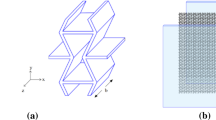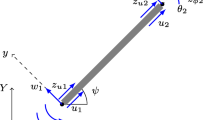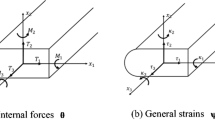Abstract
This paper deals with the problem of minimizing the vibration amplitude response of a lightweight building from rotating machinery by extended topology optimization of a flexible, single material base plate for the machinery. A modular lightweight building is modeled and used for the analysis of the vibrational response. The excitation frequency is assumed to be given, and the design objective is chosen as minimization of the product of the frequency response of the building transmitted from the machinery base plate, and the volume of solid material used in the design of the base plate. The design and performance of optimized machinery base plates are illustrated and discussed by means of numerical example problems with different excitation frequencies, different levels of Rayleigh damping, and different installation positions of the base plate with the machinery in the building. Finally, the satisfaction of the KKT (Karush-Kuhn-Tucker) necessary condition for optimality is investigated for one of the numerically optimized designs.












Similar content being viewed by others
References
Andersen LV, Kirkegaard PH, Persson K, Kiel N, Niu B (2012) A modular finite-element model for analysis of vibration transmission in multi-storey lightweight buildings. Proceedings of the Eleventh International Conference on Computational Structures Technology (CST2012). Civil-Comp Press, Dubrovnik
Arora JS (2004) Introduction to optimum design, 2nd edn. Elsevier Academic Press, Amsterdam
Bendsøe MP (1989) Optimal shape design as a material distribution problem. Struct Optimization 1(4):193–202
Bendsøe MP, Sigmund O (2003) Topology optimization: theory, methods and applications. Springer, Berlin
Bendsøe MP, Lund E, Olhoff N, Sigmund O (2005) Topology optimization—broadening the areas of application. Control Cybern 34(1):7–35
Bendsøe MP, Olhoff N, Sigmund O (2006) (Eds.) Proc. IUTAM Symp. topological design optimization of structures, machines and materials—status and perspectives, Copenhagen, Denmark, 26–29 October 2005. Springer, Berlin
Bourdin B (2001) Filters in topology optimization. Int J Numer Methods Eng 50(9):2143–2158
Bruns TE, Tortorelli DA (2001) Topology optimization of non-linear elastic structures and compliant mechanisms. Comput Methods Appl Mech Eng 190(26-27):3443–3459
Calvel S, Mongeau M (2007) Black-box structural optimization of a mechanical component. Comput Ind Eng 53(3):514–530
Cheng G, Yan J (2014) Feasible domain and optimum topology of frames subject to frequency constraints. Proceedings of the Twelfth International Conference on Computational Structures Technology (CST2014). Civil-Comp Press, Naples
Christensen BB (2008) Topology optimization: chapter 4 -topology optimization of the base plate for single-stage centrifugal pump. Master Thesis, Aalborg University, Aalborg
Cook RD, Malkus DS, Plesha ME, Witt RJ (2002) Concepts and applications of finite element analysis. Wiley, New York
Dahl J, Jensen JS, Sigmund O (2008) Topology optimization for transient wave propagation problems in one dimensional design of filters and pulse modulators. Struct Multidiscip Optim 36(6):585–595
Deaton JD, Grandhi RV (2014) A survey of structural and multidisciplinary continuum topology optimization: post 2000. Struct Multidiscip Optim 49(1):1–38
Diaz AR, Kikuchi N (1992) Solutions to shape and topology eigenvalue optimization problems using a homogenization method. Int J Numer Methods Eng 35(7):1487–1502
Du J, Olhoff N (2007a) Topological design of freely vibrating continuum structures for maximum values of simple and multiple eigenfrequencies and frequency gaps. Struct Multidiscip Optim 34(2):91–110
Du J, Olhoff N (2007b) Topological design of freely vibrating continuum structures for maximum values of simple and multiple eigenfrequencies and frequency gaps. Struct Multidiscip Optim 34(6):545, Editors’s Erratum
Eschenauer HA, Olhoff N (2001) Topology optimization of continuum structures: a review. Appl Mech Rev 54(4):331–389
Fulford RA, Gibbs BM (1999) Structure-borne sound power and source characterization in multi-point-connected systems, part 2: about mobility functions and free velocities. J Sound Vib 220(2):203–224
Guo X, Cheng G (2010) Recent development in structural design and optimization. Acta Mech Sinica 26(6):807–823
Halkjaer S, Sigmund O, Jensen JS (2006) Maximizing band gaps in plate structures. Struct Multidiscip Optim 32(4):263–275
Hu YD (1990) Practical multi-objective optimization. Shanghai Scientific and Technical Press, Shanghai
Hussein MI, Hamza K, Hulbert GM, Scott RA, Saitou K (2006) Multiobjective evolutionary optimization of periodic layered materials for desired wave dispersion characteristics. Struct Multidiscip Optim 31(1):60–75
ISO (1997) ISO 2631-1: mechanical vibration and shock evaluation of human exposure to whole-body vibration. Part 1: general requirements. International Organization for Standardization, Geneva
ISO (2003) ISO 2631-2: mechanical vibration and shock evaluation of human exposure to whole-body vibration. Part 2: vibration in buildings (1 Hz to 80 Hz). International Organization for Standardization, Geneva
Jensen JS (2003) Phononic band gaps and vibrations in one- and two-dimensional mass-spring structures. J Sound Vib 266(5):1053–1078
Jensen JS (2007) Topology optimization of dynamics problems with Pade approximants. Int J Numer Methods Eng 72(13):1605–1630
Jensen JS, Pedersen NL (2006) On maximal eigenfrequency separation in two-material structures: The 1D and 2D scalar cases. J Sound Vib 289(4-5):967–986
Jog CS (2002) Topology design of structures subjected to periodic loading. J Sound Vib 253(3):687–709
Kang Z, Zhang X, Jiang S, Cheng G (2012) On topology optimization of damping layer in shell structures under harmonic excitations. Struct Multidiscip Optim 46(1):51–67
Larsen AA, Laksafoss B, Jensen JS, Sigmund O (2009) Topological material layout in plates for vibration suppression and wave propagation control. Struct Multidiscip Optim 37(6):585–594
Le C, Bruns TE, Tortorelli DA (2012) Material microstructure optimization for linear elastodynamic energy wave management. J Mech Phys Solids 60(2):351–378
Ma ZD, Kikuchi N, Cheng HC (1995) Topological design for vibrating structures. Comput Methods Appl Mech Eng 121(1-4):259–280
Ni C, Yan J, Cheng G, Guo X (2014) Integrated size and topology optimization of skeletal structures with exact frequency constraints. Struct Multidiscip Optim 50(1):113–128
Niu B, Olhoff N (2012) Minimization of structure-borne noise in lightweight buildings. Proceedings of the 23rd International Congress of Theoretical and Applied Mechanics (ICTAM). Beijing, China
Niu B, Yan J, Cheng G (2009) Optimum structure with homogeneous optimum cellular material for maximum fundamental frequency. Struct Multidiscip Optim 39(2):115–132
Niu B, Andersen LV, Kiel N, Flodén O, Sandberg G (2012) Vibration transmission in a multi-storey lightweight building: a parameter study. Proceedings of the Eleventh International Conference on Computational Structures Technology (CST2012). Civil-Comp Press, Dubrovnik
Olhoff N, Du J (2006) Topological design optimization of vibrating structures. CJK-OSM 4: The Fourth China-Japan-Korea Joint Symposium on Optimization of Structural and Mechanical Systems: 509-514
Olhoff N, Niu B, Cheng G (2012) Optimum design of band-gap beam structures. Int J Solids Struct 49(22):3158–3169
Pavic G, Elliott AS (2010) Structure-borne sound characterization of coupled structures—Part I: simple demonstrator model. J Vib Acoust 132(4):041008
Pedersen NL (2000) Maximization of eigenvalues using topology optimization. Struct Multidiscip Optim 20(1):2–11
Rozvany GIN (2009a) A critical review of established methods of structural topology optimization. Struct Multidiscip Optim 37(3):217–237
Rozvany GIN (2009b) Traditional vs. extended optimality in topology optimization. Struct Multidiscip Optim 37(3):319–323
Rozvany GIN, Zhou M, Birker T (1992) Generalized shape optimization without homogenization. Struct Optimization 4(3–4):250–252
Rozvany GIN, Querin OM, Gaspar Z, Pomezanski V (2002) Extended optimality in topology design. Struct Multidiscip Optim 24(3):257–261
Sigmund O (2007) Morphology-based black and white filters for topology optimization. Struct Multidiscip Optim 33(4-5):401–424
Sigmund O, Jensen JS (2003) Systematic design of phononic band-gap materials and structures by topology optimization. Philos Trans R Soc London, Ser A 361(1806):1001–1019
Sigmund O, Maute K (2013) Topology optimization approaches. Struct Multidiscip Optim 48(6):1031–1055
SIMULIA (Dassault Systèmes Corp.) (2011) ABAQUS Analysis User’s Manual Version 6.11, Providence, RI, USA
Svanberg K (1987) The method of moving asymptotes—a new method for structural optimization. Int J Numer Methods Eng 24(2):359–373
Tcherniak D (2002) Topology optimization of resonating structures using SIMP method. Int J Numer Methods Eng 54(11):1605–1622
The MathWorks Inc. (2010) MATLAB version 7.11.584 (R2010b). Natick, Massachusetts
Tortorelli DA, Michaleris P (1994) Design sensitivity analysis: overview and review. Inverse Prob Eng 1(1):71–105
Williams FW, Wittrick WH (1970) An automatic computational procedure for calculating nature frequencies of skeletal structures. Int J Mech Sci 12(9):781–791
Yoon GH (2010) Structural topology optimization for frequency response problem using model reduction schemes. Comput Methods Appl Mech Eng 199(25–28):1744–1763
Acknowledgments
This work has been funded by the EU InterReg Project “Silent Spaces” and Aalborg University. Valuable discussions with Prof. Ole Sigmund of the Technical University of Denmark are gratefully acknowledged.
Author information
Authors and Affiliations
Corresponding author
Rights and permissions
About this article
Cite this article
Olhoff, N., Niu, B. Minimizing the vibrational response of a lightweight building by topology and volume optimization of a base plate for excitatory machinery. Struct Multidisc Optim 53, 567–588 (2016). https://doi.org/10.1007/s00158-015-1345-6
Received:
Revised:
Accepted:
Published:
Issue Date:
DOI: https://doi.org/10.1007/s00158-015-1345-6




